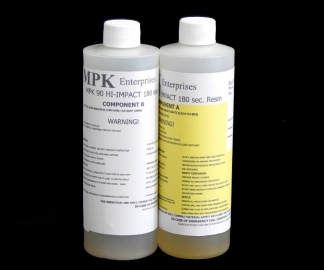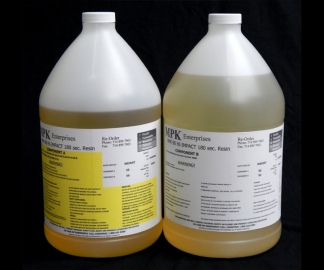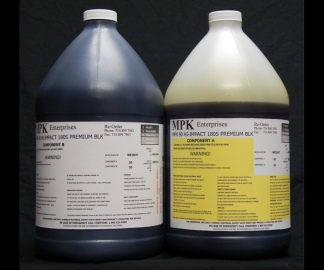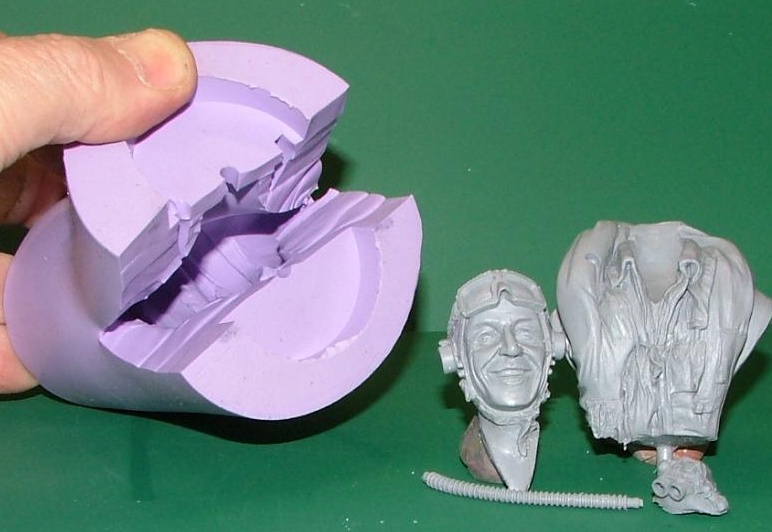Living, as I do, on the other side of the world in a place where the range of resins and silicone rubbers available locally is very limited I have been delighted to strike up a commercial relationship with Hobby Silicones who have proven to be an important resource for me in helping to sort out suitable resins and RTV for my applications. I am a contract caster of components for manufacturers of hobby kits in the railway and figurine fields.
There have been some particular logistical hurdles to overcome to get supplies to me and I am most impressed with the way that they have cheerfully gone the extra mile to ensure that I receive product in a timely manner.
Resin:
I use MKP resin with a pot life of 3 minutes which suits our moderate climate and gives me time to de-air comfortably. I have been very impressed with the way this resin pours well into very fine detail so that de-airing does not have to be prolonged. Whilst simple flat back castings can be de-molded within an hour or so (or sooner if I use a temperature controlled curing environment with the thermostat set at 30 deg C) I tend to leave complex castings with fine detail for several hours under that level of heat to ensure adequate polymer linking that results in incredibly strong castings with a consistency similar to high impact styrene. These castings have high resilience without being unduly flexible. My customers prefer their castings to be made in a neutral gray color and I find the natural white color of this resin accepts grey toner pigment well.
-
 2 lb Kit : MPK-90 : Hi Impact 3 Min. Polyurethane Casting Resin$22.99
2 lb Kit : MPK-90 : Hi Impact 3 Min. Polyurethane Casting Resin$22.99 -
 16 lb Kit : MPK-90 : Hi Impact 3 Min. Polyurethane Casting Resin$109.99
16 lb Kit : MPK-90 : Hi Impact 3 Min. Polyurethane Casting Resin$109.99 -
 2 lb Kit : MPK-90PB :3 Min Hi Impact PREMIUM BLACK Polyurethane Casting Resin$22.99
2 lb Kit : MPK-90PB :3 Min Hi Impact PREMIUM BLACK Polyurethane Casting Resin$22.99 -
 16 lb Kit : MPK-90PB : 3 Min Hi Impact PREMIUM BLACK Polyurethane Casting Resin$109.99
16 lb Kit : MPK-90PB : 3 Min Hi Impact PREMIUM BLACK Polyurethane Casting Resin$109.99
RTV:
My needs for RTV range from semi-rigid with a low tolerance to shrinkage (railway kit components that need to be able to be assembled with one another) through to highly flexible where a minimum of cutting to enable complex castings to be removed is desirable to minimize part lines (figurines), Hobby Silicones have been able to identify for me the types of RTV that best suits my needs. I am impressed by the way that the MPK branded soft, medium and firm consistency rubbers release easily from patterns thereby not subjecting delicate patterns to possible harm and the way they release resin castings with only a light application of release agent. More recently I have been introduced to QSI 2125 which behaves just like the MPK branded rubber and to QSI 230 which is a platinum cure RTV and which is maintaining excellent dimensional stability. Even though a more rigid rubber, the 230 still releases cleanly from patternwork and releases the resin castings well.
In all cases these rubbers reproduce the fine detail of the patternwork without fault.
I have developed what I call a pouch mold that enables reasonably complex one piece castings to be made with a fully enclosed mold that has a slit for filling of the resin and removal of the casting. I’m sure others must have thought of it as well but I have not seen it demonstrated in my searches.
Some of the parts I make are of very thin section relative to their size and this method produces consistently good castings.
The SRC roof is a curved sheet about 1.0mm thick with detail on one side and arched ribbing on the other. It is the roof for a NSWGR box wagon. The casting is about 6.5 x 3 inches.
The hopper sides have rivet detail on the outside and channel bracing on the inside. They are for a NSWGR hopper car. These castings are about 9″ x 2.5″
The one piece flat car body is for a smaller scale Queensland Rail model. It is about 7 x 1.25″ with detail both sides that is delicate and easily damaged on removal, but using heat to ensure good polymer linkage takes care of that.
The pilot bust is a 1/6 scale person. You can see how the flexibility of the soft RTV pot mould aids removal of the bust without needing to cut into the area where it might show on detail.
by:
Nelson Kennedy
Christchurch, New Zealand



